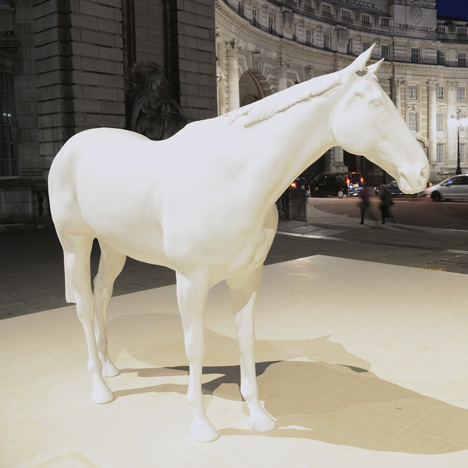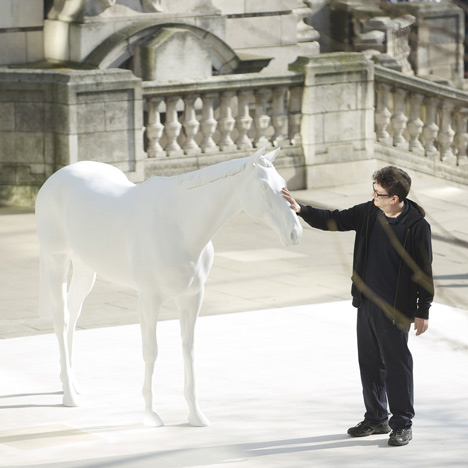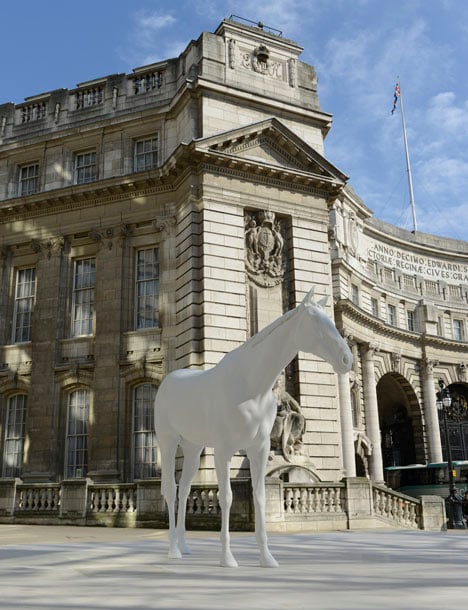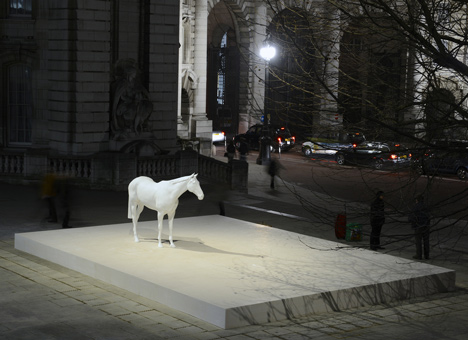
London studio creates 3D scan of horse
News: Hackney studio Sample and Hold 3D-scanned a living horse for a new sculpture by Turner Prize-winning artist Mark Wallinger.
Unveiled this week on The Mall in London, The White Horse is a scaled-down version of a 50-metre-high sculpture Wallinger eventually hopes to build in Ebbsfleet, Kent.

Technicians at Sample and Hold helped create the sculpture by using a white light scanner to produce a 3D image of a racehorse named Riviera Red.
By projecting a grid of white light onto the horse's body and recording the resulting distortions, the technicians built up a three-dimensional map of the animal's shape. The 3D image was then used to make a mould to cast the sculpture from a mixture of marble dust and resin.

The horse was unveiled this week outside the headquarters of the British Council, the cultural institution that commissioned the artwork, where it will remain for two years before going on an international tour.
Wallinger hopes the life-size sculpture will re-ignite interest in his larger project in Ebbsfleet, which was commissioned in 2009 but stalled when the UK went into recession. The costs of the project are believed to be between £12 million and £15 million.

Like 3D printing, 3D scanning is becoming increasingly accessible and affordable – earlier this week we reported on a prototype for a desktop scanner that would allow users to digitally scan objects they want to replicate with a 3D printer at home.
Photographs are by Frank Noon for the British Council.
Here's some more information from the British Council:
‘The White Horse’, a new sculpture by Mark Wallinger, was unveiled outside the British Council’s London headquarters on the Mall today. Made of marble and resin, the sculpture is a life-size representation of a thoroughbred racehorse created using state of the art technology in which a live horse has been scanned using a white light scanner in order to produce a faithfully accurate representation of the animal standing on a broad plinth of Portland stone and facing down The Mall.
Commissioned by the British Council Collection, this major work will stand on The Mall for two years before becoming available for international display.
In 2008, Mark Wallinger won The Ebbsfleet Landmark Project, an international competition to build a monument at Ebbsfleet in Kent. Wallinger’s winning entry, a white horse, 25 times life-size, and standing some 50 metres tall, was designed to look out over what was once Watling Street. The White Horse in Spring Gardens is a life-sized version of this sculpture.
The White Horse illustrates Wallinger’s continuing fascination with the horse, and its emblematic status in our national history. The origins of the white horse as the emblem of Kent can be traced from 'Horsa' - the derivation of the modern word horse - a semi-mythological Anglo-Saxon leader who landed near Ebbsfleet on the Isle of Thanet in the 6th century. The White Horse sculpture relates to the ancient history of hillside depictions of white horses in England but the pose is familiar from current depictions of thoroughbred stallions and has been replicated throughout the history of art from Stubbs’ painting of Eclipse to Wallinger’s own paintings of stallions from the Darley Stud.
The Thoroughbred was first developed at the beginning of the 18th century in England, when native mares were crossbred with imported Arabian stallions. Every racehorse in the world is descended from these animals. 90% from the Darley Arabian, the most dominant influence on the breed.
The proximity of the equestrian statues of Charles I and George IV on Trafalgar Square, and the Piazza’s location only a stone's throw from Horse Guards Parade, make the siting of this sculpture particularly resonant. As does the fact that The Mall remains a processional route of cavalry parades.
Andrea Rose, Director Visual Arts, British Council, said: “A white horse in the centre of London is a wonderful sight. It sparks associations - ancient and modern; war and peace; rural and urban; sport and pleasure. I hope it puts a spring in the step of all who pass it on the Mall.”